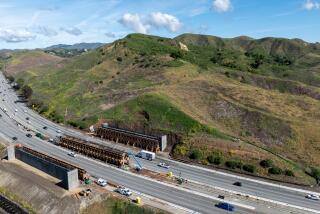Off the Beaten Path : Biologist Is Honored as a Roadside Refuge Begins to Take Root
NEWPORT BEACH — Laura Coley Eisenberg can see into the future.
The new growth in the middle of a muddy trench along the San Joaquin Hills toll road might look like weeds to the casual observer. But to Eisenberg, it is the beginning of a saltwater marsh that within five years will be a habitat for wildlife and a haven for endangered birds that now nest in nearby Bonita Reservoir.
“It will be beautiful,” said Eisenberg, a biologist for the Transportation Corridor Agencies who helped to design the refuge and is responsible for monitoring it. “It’s off to a great start. We are really quite proud of it so far.”
So, it seems, is the federal government. In celebration of Earth Day today, Eisenberg will be in Washington to accept one of seven awards given by the Federal Highway Administration.
The citations go to agencies that have used federal money for transportation projects sensitive to the environment. This year more than 150 entries from 34 states competed for the honors. The Orange County project is the only California winner this year.
The federal officials judging the entries described the tollway’s Newport Beach wetlands area as “an innovative . . . multihabitat restoration project.”
The toll road “was a challenging project with overwhelming community concern,” said Jane Garvey, acting chief of the Federal Highway Administration in Washington. “The result is a habitat corridor that actually improves wildlife movement and creates a potential nesting area for sensitive bird species.”
That the road could win such kudos is ironic to some of the community activists who campaigned tirelessly to block its construction, and many are not convinced that irreparable damage has not been done.
“That entire road is a setback,” said Mia Doran, a Laguna Beach environmentalist. “Getting the area established enough to call a real habitat is going to take time.”
The 15-mile, $1.5-billion road, begun in 1993 and completed last year, is part of 70 miles of Orange County tollways to be completed by 2003.
Dozens of injunctions were filed to stop the San Joaquin Hills project. When it was finally cleared to proceed, state and federal wildlife officials ordered the tollway agency to pay particular attention to the wetlands near Bonita Reservoir.
The 256-acre area, singled out for the Earth Day honors, is known as the Coyote Canyon-Bonita Creek Wildlife Corridor. It links the San Joaquin Hills to the San Diego Creek and Upper Newport Bay systems.
The $25-million restoration included the planting of thousands of shrubs that will grow willows, sycamores, cattails and coastal sage scrub. Four animal crossings run beneath the road.
One environmental concern was that the road’s construction would displace as many as 30 pairs of the endangered gnatcatcher. As part of the Coyote Canyon project, a closed county landfill has been planted with the sage scrub in which the gray-blue songbird thrives.
“For years, during all of the opposition and concerns about this project, we’ve had to bite our tongues and bide our time,” said Peter Buffa, chairman of the Transportation Corridor Agencies.
“We’ve always had a strong interest in protecting the environment. We knew we would make it better. And now it’s especially nice to be recognized for it.”
More to Read
Sign up for Essential California
The most important California stories and recommendations in your inbox every morning.
You may occasionally receive promotional content from the Los Angeles Times.










